Community-Based Approach to Wetland Restoration: Case Study of the Songor Wetland, Ghana (SITR8-8)
20.03.2024
SUBMITTING ORGANIZATION
Conservation Alliance International
DATE OF SUBMISSION
19/09/2023
REGION
Africa
COUNTRY
Ghana
AUTHOR(S)
Raymond Owusu-Achiaw
Yaw Osei-Owusu
LINK
1 Introduction
Tropical wetlands play an important role in biodiversity conservation. According to Raburu et al. (2012), tropical wetlands provide biodiversity and ecosystem services that are vital for the survival of a wide range of both flora and fauna. Additionally, they serve as important habitats for both aquatic and other wetland-dependent species (Quarto and Thiam 2018). Wetlands also support the health and productivity of seascapes and landscapes, especially mangroves. Furthermore, wetlands play an important, life-supporting role for countless coastal communities and local people, who depend on wetlands for life and livelihoods (Raburu et al. 2012). They are also recognised for their important role in mitigating climate change, sequestering up to five times more carbon than other terrestrial forest ecosystems, and also serving as living buffers against the forces of storms and waves that can otherwise devastate a coastline (Raburu et al. 2012).
The Songor Wetland is one of the coastal wetlands in Ghana that has been designated as a Ramsar site under the Ramsar Convention on Wetlands and is also listed as a biosphere under UNESCO’s Man and Biosphere (MAB) Programme. It covers an area of 11,500 ha, extending 20 km along the coast and 8 km inland behind a narrow strip of sand dunes on which small communities are situated. The wetland acts as a habitat and breeding ground for several species of both economic and ecological importance. Thus it has multi-functional benefits relating to the ecosystem, the economy, and ecotourism (Ghana National MAB Committee 2009). However, studies have also identified threats to the wetland, including over-fishing, pollution, mangrove exploitation, invasive species, infrastructure development, and bushfires (Fianko and Dodd 2018). These threats are compounded by other challenges, such as poor perception of public ownership of resources, limited commitment to sustainable use, and weak enforcement of laws governing natural resources. Such threats and challenges to the sustainable management and conservation of the wetland indicate that its socio-cultural importance has virtually been lost to the fringe communities.
In 1999, the Government of Ghana developed the Songor Ramsar Site Management Plan under the Coastal Wetlands Management Project (CWMP) to address threats facing the Songor Wetland and to enhance its conservation status in Ghana. A key component of the management plan was the participation and inclusion of local communities in the ecological restoration (Ofori-Danson 1999). The inclusion of local communities in restoring the wetland was re-emphasised by the Ghana National Man and Biosphere (MAB) Committee (2009) as one of the surest ways of enhancing the wetland’s ability to sustain biodiversity and provide ecosystem services to improve the socio-economic and environmental conditions of the local people. Various studies have revealed the critical role of community engagement and involvement in restoration practices, including planting of mangroves, agroforestry, and afforestation (Abdullah et al. 2014; Francis et al. 2015; Tomeo et al. 2018).
Communities on the fringe of the Songor Wetland have adopted various strategies to address threats to the wetland in order to improve the socio-ecological health of the landscape and enhance their well-being. The wetland serves as a strategic livelihood support system and economic lifeline for the communities through its fisheries, minerals, and ecotourism resources, as well as its good edaphic conditions for agricultural purposes (Fianko and Dodd 2018). Communal restoration activities have been undertaken in the wetland in partnership with civil society organisations, government entities, the private sector, and academia, amongst others, as recommended in the Songor Ramsar Site Management Plan. However, few or no comprehensive studies have been conducted to understand how communal approaches are being applied to restore the ecosystem of the wetland and which communal approaches are effective in addressing current and emerging threats. Likewise, studies were needed on the challenges faced by these communal approaches and lessons that can be learnt for improvement, scalability, and/or replicability.
Due to the ecological importance of the wetland and threats to it, Conservation Alliance International (CA) carried out a number of activities, including community education on conservation measures, to assist in community restoration efforts and evaluation of restoration efforts carried out within the fringe communities for lesson learning. Additionally, CA-led efforts to carry out several wetland restoration activities jointly with different stakeholders, including communities, civil society organisations, government entities, the private sector, and traditional authorities, as recommended by the Songor Ramsar Site Management Plan from 2015 to 2020. One key element of the CA-led restoration exercises was the integration of local and traditional knowledge and cultural values to facilitate the restoration of the Songor Wetland. At the end of the 5-year restoration period, CA also evaluated the different restoration approaches that had been adopted on all restored areas for replication, scalability, and lessons for socio-ecological production landscapes and seascapes (SEPLS) management.
To examine communal approaches to restoring the Songor Wetland landscape, CA conducted a study within the landscape. The main objective of this study was to gain a better understanding of communal approaches to wetland restoration and their role in enhancing the socio-ecological health of the Songor Wetland landscape of Ghana. Specifically, the study sought to:
- Assess the ecological value of the wetland for the communities.
- Determine communal approaches/coordination to enhance the ecological restoration of the wetland.
- Document current management practices undertaken within the communal restoration approaches.
- Assess emerging challenges to community approaches to wetland restoration.
2 Methodology
2.1 Study Area
The Songor Wetland is located in the Greater Accra Region and was designated as a Ramsar site in 1992. It falls on the boundary of two flyways of water birds, the East Atlantic Flyway, and the Mediterranean Flyway. According to the 1971 Ramsar Convention on Wetlands of International Importance, wetlands are areas of land whose soil is saturated with moisture permanently or seasonally and are covered partially or completely with shallow pools which may be freshwater, saltwater, or brackish. The Songor Wetland has an abundance of all types, both freshwater, saltwater, and brackish wetlands (Ntiamoa-Baidu and Gordon 1991). The wetland protects some animal species listed in the IUCN Red List that are also protected in Ghana. It has the highest total tern count on the Ghana coast and supports naturally important populations (over 10% of the total coastal count) of at least 23 species of water birds (Piersma and Ntiamoa-Baidu 1995). The area is well known for its development, particularly involving tourism and salt production. Communities are also known to be very receptive to conservation projects (Ghana National MAB Committee 2009). According to Fianko and Dodd (2018), the Songor Wetland is divided into three main sections, namely the Core Area, Buffer Area, and Transition Area (Fig. 9.1).
The Core Area in the south is regarded as having the most important feeding and roosting sites for water birds, as well as nesting sites for marine turtles and fish species. It has two ecosystem types—marine and brackish lagoons. The Buffer Area is composed of the northern sections of the open lagoons and the surrounding floodplain, as well as some coastal land. Its ecosystem is also suitable for the breeding of fish, birds, and nesting turtles, and is thus very sensitive. The area is characterised by land use types such as farming, controlled salt mining, fishing, tourism, and aquaculture on a minor scale. There is an enormous potential for the development of both aquaculture and salt production on an industrial scale. The Transition Area is mainly composed of settlements with a thin stretch of coastline on both ends. This area is fast developing. Current land uses include aquaculture, markets, schools, mechanised shops, and tourism. Additional information on the project area can be found in Table 9.1.
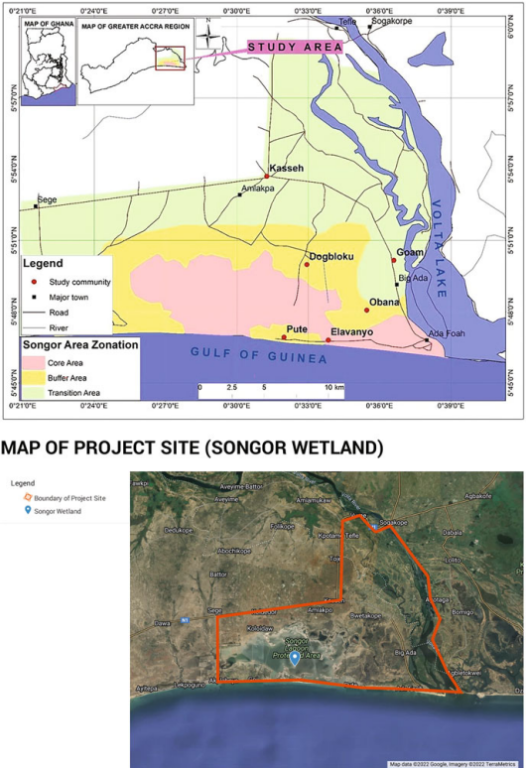
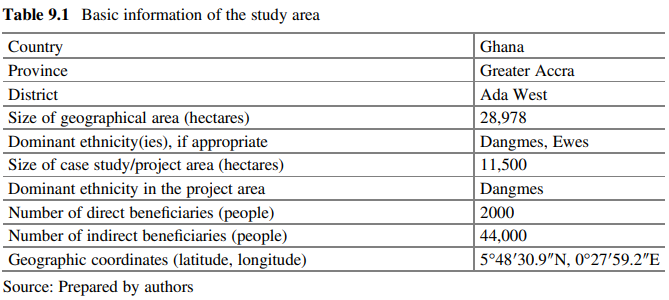
2.2 Study Population and Sampling Method
According to Ghana Statistical Service (2021), the total population of the Songor Wetland is about 152,498 people with a split number of males (49.9%) and females (50.1%). A simple random sampling technique was adopted to select respondents for the study. A sample size of 376 was derived from the random selection of respondents of which 146, 130, and 100 were from the Core, Buffer, and Transition Areas, respectively, based on their relative populations (Kirk 2011; Etikan and Bala 2017). The sample sizes were further divided to get an equal representation of gender, thus 188 respondents for both males and females were sampled.
2.3 Data Collection
Both quantitative and qualitative research approaches were employed. Likewise, both primary and secondary data constituted a useful set of data that defined the state of restoration activities and their impacts on the socio-ecological status of the Songor Wetland. Farmer surveys, community consultations, focus group discussions (FGDs), district-wide stakeholder consultations, and key informant interviews constituted the main strategies to generate primary data. Questionnaires for surveying farmers were pre-tested using a selected group of respondents outside the target
population to ensure the reliability and validity of the questions and responses.
Secondary data were collected from various sources including public records, institutional documents, management plans, policy statements, official publications, and other research works. Reviews of government documents on the Songor Ramsar Site Management Plan under the Coastal Wetlands Management Project (CWMP), including operational manuals and monitoring reports, constituted another form of data collection.
A participatory approach through FGDs was used to obtain information on the different communal restoration models that were implemented to improve degraded portions of the wetland. Two FGDs were conducted between 2020 and 2021. A community-based evaluation approach was used to evaluate the success of the different communal approaches based on each approach’s effectiveness in responding to a set of restoration criteria (e.g. mangrove restoration, woodlot planting, control of invasive species, amongst others). Approaches were scored according to the following: 1—Very Unsatisfactory, 2—Unsatisfactory, 3—Weak Satisfactory, 4—Satisfactory, and 5—Very Satisfactory. Two evaluations were conducted between 2020 and 2021. The 27 representatives of relevant stakeholder groups that participated in the FGDs and the evaluations are shown in Table 9.2.
Two series of interviews were also conducted with the Wildlife Division (WD), Environmental Protection Agency (EPA), the traditional authorities, companies, and civil society groups, amongst others, to assess the threats to the Songor Wetland and efforts to address them through restoration exercises. Additionally, a Community Ecosystem Service Value Typology (CESVT) was used to assess how fringe communities value the wetland’s ecosystem services. This information provided an insight into how this perceived value is likely to motivate certain community behaviours and facilitate the design of appropriate biodiversity conservation projects.
2.4 Data Analysis
The data collected were coded and analysis was carried out using Microsoft Excel and Statistical Package for Social Sciences (SPSS) version 27. The statistical outputs generated were summarised in tables for simplicity of interpretation. The analysis was done using descriptive statistics where issues of similarity and dissimilarity of responses were compared. The descriptive statistical analysis facilitated the quantitative comparison of the responses.
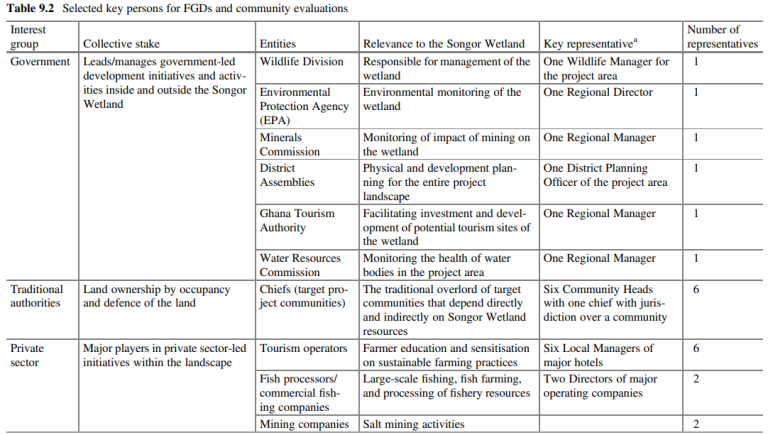
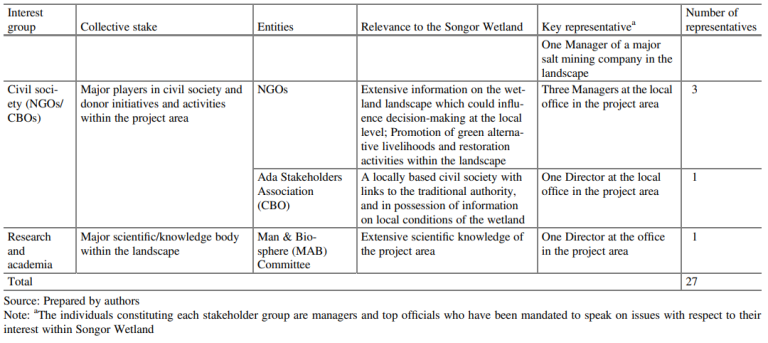
3 Results
3.1 Demographic Characteristics of Respondents
Statistics on key demographic characteristics that were generated during the study included the age, level of education, and occupation of respondents (Table 9.3). More than half (55.5%) of the respondents were male, arising from the dominance of males in the use of the Songor Wetland (Table 9.2). Additionally, 80% of the respondents were below the age of 50, and 63.9% practised agriculture as their main occupation. Education plays a significant role in the acquisition and use of science and new technologies to undertake restoration activities. More than 50% of respondents had no formal education. As such, concerted efforts on awareness raising and capacity building to enhance restoration activities will be required.
3.2 Assessment of the Ecological Value of the Songor Wetland
As noted above, a CESVT approach was adopted to determine the perceived value communities place on the Songor Wetland ecosystem (Table 9.4). Most respondents put a higher premium on provisioning services, accounting for 53% of responses on the ecosystem services delivered by the Songor Wetland. This result shows how communities rely mostly on these services (provisioning) for their daily sustenance or livelihoods. Provisioning services provided by the wetland include fishes, oysters, fuelwood, and crabs, amongst others. Next was supporting services (31%) that are necessary to produce all other ecosystem services, including soil formation and retention, water cycling, nutrient cycling, primary production, production of atmospheric oxygen, and provision of habitat for biodiversity. Some regulating services provided by the wetland include erosion control, carbon sinks, and climate regulation. Cultural services include aesthetic inspiration that provides opportunities for tourism and recreation as well as spiritual affinity for the sea turtles.
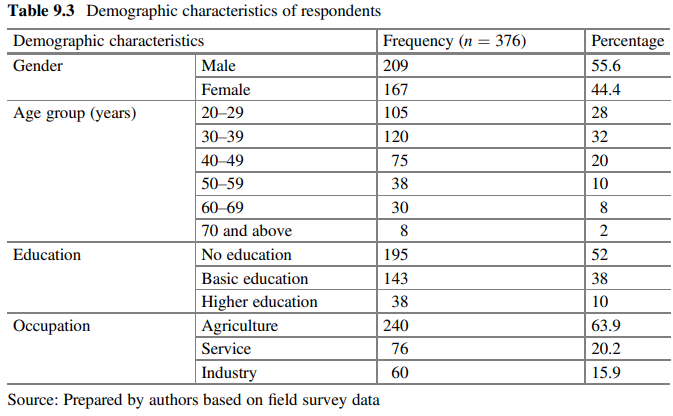


There were observed disparities in values across and within each ecosystem service perceived by the different community groups. The main driver of these disparities was how each ecosystem service was contributing to livelihood sustenance. Farmers, fishermen, and fishmongers, as well as men’s groups, found the most value in provisioning services, which have the most direct impact on their livelihoods (Fig. 9.2). Sustenance of livelihoods is essential no matter the sources of livelihoods. This explains why community members are likely to buy into ecosystem restoration activities provided restoration improves supporting services that enhance their livelihoods. Regulating services were mostly relegated by community members as less valuable in comparison to provisioning and supporting services. Discussions through community meetings revealed that elements of regulating services’ value were too technical and scientific for the community members to fully understand and appreciate. Furthermore, the traditional authorities, as the custodians of the cultural integrity of the landscape, attributed a comparatively higher value to cultural services compared to the other community groups. The mostly intangible nature of cultural services was revealed to be one of the reasons for the low value attributed by community members. The study revealed that the socio-cultural value of the landscape is gradually being lost to the youth for multiple reasons, including foreign cultural influence, reduced socio-cultural education, and lack of proper integration of youth into the cultural discourse.
3.3 Communal Approaches to Ecological Restoration of the Wetland
The study revealed that communities use diverse approaches and strategies to undertake restoration activities within the Songor Wetland (Fig. 9.3). The Community Resource Management Committee (CRMC) model accounted for about 67% of approach and coordination strategies for wetland restoration by the communities, followed by tradition-led beliefs in a distant second (17%).
The CRMC model has been very successful for most restoration activities because it is hinged on the concept of inter-agency approach/coordination (a multi-stakeholder approach). Inter-agency coordination is coordination that occurs between government agencies, private sector operators, non-governmental organisations, and regional and international organisations for the purpose of accomplishing a common objective. This approach has allowed for all stakeholders to make concerted efforts in a coordinated manner to restore the Songor Wetland, whilst also allowing for mainstreaming of restoration lessons at the local level through the district assembly. The conceptual framework of the CRMC model is shown in Fig. 9.4.
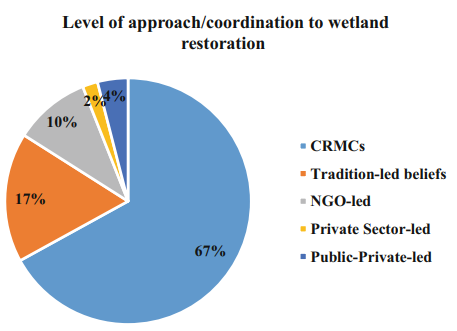
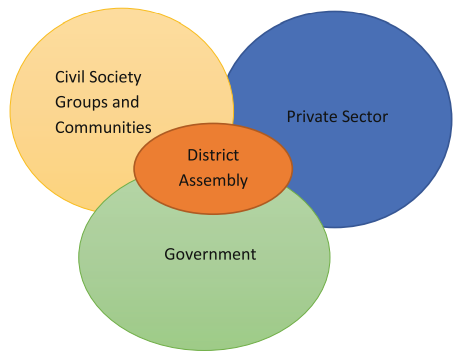
3.4 Current Management Practices Under the Communal Restoration Approaches
Current management practices carried out through communal approaches are aimed at biodiversity conservation, recovery of species, improvement of community livelihoods, and also enhancement of the socio-cultural value of the wetland. Restoration exercises included mangrove restoration, woodlot establishment, clearing of aquatic weeds, location of disoriented turtles, pest control, and data collection for monitoring (Fig. 9.5). These management practices were intended to prevent, halt, and reverse the degradation of the wetland in order to sustain the biodiversity and ecosystem services enjoyed by the local communities. Thus, ecosystem integrity and the sustainable development of the Songor Wetland and its fringe communities were
expected to be enhanced through the adoption of these management practices.Additionally, alternate fuelwood was also provided to community members to reduce mangrove exploitation. Most of the restoration activities focused on mangrove restoration (55%), since unsustainable mangrove exploitation is the single most significant threat to the survival of the wetland. The next most common restoration activity was woodlot establishment (20%), as communities need alternate fuelwood to reduce their dependence on mangroves for wood products, including fuel. The mangrove ecosystem was restored with species such as Rhizophora mangle (red mangrove) and Laguncularia racemosa (white mangrove), which are native to the Songor Wetland, also aimed at enhancing the natural habitats of some biological elements (e.g. spawning fishes and sea turtles)(Fig. 9.6). Woodlots were established with Acacia mangium (mangium), which is fast growing and a soil nitrogen fixer, to produce an alternative source of fuelwood. Restoration activities such as clearing of aquatic weeds, location of disoriented turtles, pest control, and data collection for monitoring complemented the main restoration activities (e.g. mangroves and woodlots) and constituted the smallest number of restoration activities undertaken under the management practices.
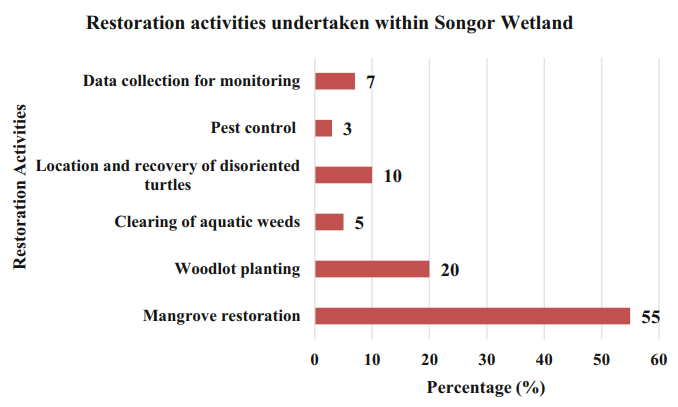

The study also evaluated the response of each communal restoration and the types of restoration activities undertaken within the project area to establish a success matrix for each approach. Responses from participants during the FGDs and evaluations were measured on a Likert scale and ranked in the following order: 1—Very Unsatisfactory, 2—Unsatisfactory, 3—Weak Satisfactory, 4—Satisfactory, 5— Very Satisfactory. A total score was aggregated for each communal restoration approach, as shown in Table 9.5. The CRMC model was found to be the most successful and satisfactory approach in restoring the wetland ecosystem. Its near perfect score is attributable to the involvement of all relevant actors in the restoration activities. This approach offered the most efficient mobilisation of resources (including finance), a sense of local community ownership, alignment of diverse interests, defined roles, and clear ecosystem sustainability pathways. The NGO-led approach was the second most successful and involved full community participation. One drawback was that most restoration activities were externally driven by donor funding, making sustainability an issue once funding is exhausted. The private sector-led and public-private-led approaches were deemed to be more profit-oriented in scope and lacked the full participation of community members, though funding was not a problem. Thus, sustainability through private sector- and public-privateled approaches was very low as compared to a multistakeholder approach (e.g. CRMC).
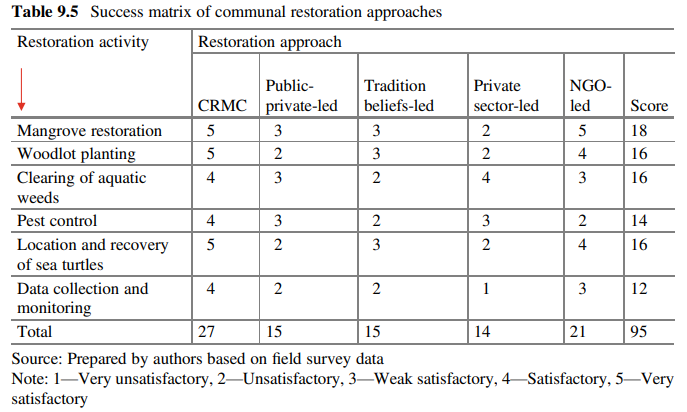
4 Discussion and Lessons Learnt
4.1 Discussion
Demographic information is an essential element in describing the characteristics of the study participants. The dominant age groups of the respondents were below 50 years. These ages indicate that the populace is more youthful, and that the bulk of persons involved were engaged in productive activities. Weiss and Börsch-Supan (2011) established that worker productivity ages amongst workers fall within the 20–50 years age bracket. Furthermore, the study revealed that 90% of the respondents had either no education or basic education. This could be one of multiple reasons that explain the weak appreciation for the value of the ecosystem goods and services provided by the Songor Wetland, as well as the many threats to it. Studies have shown that it is difficult for new innovations in conservation to be adopted by persons with only basic or no formal education (OECD 2016; Ntshangase et al. 2018). The level and quality of education tend to influence the rate of adoption of new conservation and natural resource management techniques (Brewer 2006; Coulibaly-Lingani et al. 2009). The findings of the present study showed that most community members are engaged in agriculture, which is consistent with the 2021 Ghana Population and Housing Census report, which indicated that most communities rely on fishery resources and good soil conditions in the Songor Wetland for agricultural production (Ghana Statistical Service 2021). This study also confirmed earlier studies, which indicate that the livelihoods of people within natural resourcerich areas of Ghana are predicated on subsistence agriculture (Appiah 2009; Ghana Statistical Service 2021). The CESVT approach adopted to determine the value communities place on the Songor Wetland indicated that most respondents place a higher value on the provisioning and supporting services provided by the wetland. This shows that these services are crucial to the local livelihoods. Locally, the fringe communities depend on the wetland for food, raw materials, and firewood, amongst others (Lamptey and Ofori-Danson 2014). Additionally, some researchers have argued that an in-depth understanding of how people value ecosystem services is crucial for policymakers to conceptualise the contribution of ecosystems to human society (Yang et al. 2018).
The CRMCs provided inter-agency coordination that was perceived to be the best option for landscape projects because it provides the opportunity for different actors to act in a concerted and coordinated manner to achieve set goals and targets. It also empowers government agencies to mainstream the projects into their development plans and policies both at the local and national levels. Local governments in Ghana play a key role in administration and development of local areas and associated resources. The 1992 Constitution of the Republic of Ghana, in Article 240, therefore tasks the local government authorities (Metropolitan, Municipal, and District Assemblies—MMDAs) with the planning, initiation, coordination, management, and execution of policies with respect to all matters affecting the people within their areas of jurisdiction (ILGS 2016). This means that policy planning and mainstreaming of development processes at the national level start with the local government. Thus, the CRMCs offer a model for integrating lessons learnt from communal restoration activities into development policies.
Threats to the Songor Wetland that have negative impacts on livelihoods of community members are the main drivers that motivate restoration activities within the wetland. The main restoration activities undertaken by communities to address these threats include mangrove planting and establishment of woodlots to serve as an alternative source of fuelwood to ease mangrove exploitation for fuelwood. According to Lamptey and Ofori-Danson (2014), the vigorous pursuit of simultaneous mangrove restoration and woodlot planting is likely to address more than half of the challenges facing the Songor Wetland. This is corroborated by several studies, including Abdullah et al. (2014), Francis et al. (2015), and Newaz and Rahman (2019), which revealed that community-led wetland restoration activities not only ensure the socio-ecological health of the entire wetland ecosystem, but also empower communities to take ownership of and participate in the sustainable management of their own resources.
The Songor Wetland restoration initiatives by communities also face emerging challenges due to an increasing population and the onset of urbanisation. Changing land use types, such as mining and tourism (e.g. mainly driven by the improved natural ecosystem through restoration efforts), are having the greatest impacts on restoration activities and are mostly emanating from the buffer and transition areas of the wetland. This is made worse by the invasiveness of aquatic weeds (water hyacinth), the use of agrochemicals for agricultural purposes resulting in pollution, and the erosion of coastal areas due to more tidal waves than normal. According to the Ghana National MAB Committee (2009), human impacts on the Songor wetland ecosystem are expected to increase if proper land use management practices are not put in place and implemented. For the local community, the greatest benefits are increased employment opportunities from the mining and tourism industries.
Thus, the CRMC model offers an opportunity to continually address these emerging challenges because it enhances multi-stakeholder collaboration and coordination, local community ownership, and the sustainability of restoration activities, which ultimately improve the socio-ecological health of the wetland ecosystem. The expansion of the CRMC model into the buffer and transition areas of the wetland will go a long way to further addressing these emerging threats.
4.2 Emerging Challenges to Community
Approaches to Wetland Restoration The study explored some emerging challenges that communal restoration activities have faced in the past decade that negatively affect ongoing efforts to enhance the socio-ecological health of the Songor Wetland (Table 9.6). The findings revealed that the most impacting activities were mining (30%) and tourism (24%). Others included aquatic weeds, water hyacinth (19%), use of agrochemicals (16%), and soil erosion along the coast (11%), exacerbated by impacts of the COVID-19 pandemic.
Salt mining constitutes the main mining activity within the Songor Wetland that has emerged as a risk to restoration efforts. Salt mining is carried out all year round, and three million tonnes are expected to be produced annually from 2023. The use of heavy drilling and dredging machinery, as well as the removal of vast areas of new and existing mangroves for salt processing facilities, have affected the ecological health of the wetland. According to Ekrami et al. (2021) and Gbogbo (2007), salt mining imperils the health of wetland ecosystems and the survival of biodiversity.
Restoration efforts, especially planting of mangroves and removal of water hyacinth, enhanced the ecosystem of the wetland, which attracted new hoteliers to the burgeoning tourism industry (Fig. 9.7). This led to massive infrastructure development and other pressures from increased tourism affecting the health of the ecosystem due to the habitat degradation of some key species within the wetland (e.g. marine turtles and species that thrive in the brackish ecosystem). Similar findings have revealed that the potential negative impacts of tourism on biodiversity often interact with wider landscape-level impacts such as land use changes that compromise biodiversity conservation (Ouboter et al. 2021; Newsome and Hughes 2016).
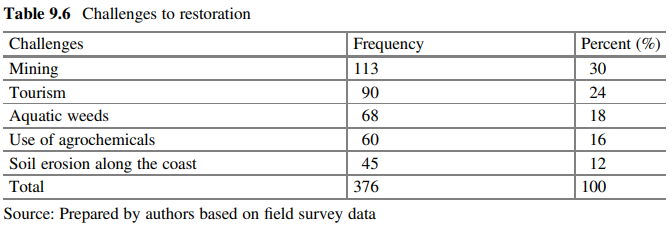

4.3 Lessons Learnt
This case study has provided important lessons from an examination of the implementation of Songor Wetland restoration activities. It gave perspectives on different approaches to communal restoration exercises. The tradition-led approach showed the importance of culture and spiritual affinity for certain biological elements (e.g. marine turtles) in motivating community members to restore the degraded wetland ecosystems. Similarly, private sector-led restoration efforts were primarily activities aimed at improving business patronage and revenues (e.g. removal of aquatic weeds). This shows that restoration activities were conducted based on interest and perceived benefits derived from ecosystem services by each stakeholder operating within the landscape. The biggest lesson is, therefore, that for restoration activities to be truly successful, the interest of diverse stakeholders ought to be considered in the restoration planning processes. This is where the CRMC model comes in handy as it takes into account the diverse stakes and interests of stakeholders during ecosystem restoration.
Evidence from the study clearly showed that livelihood improvement is a major driver that stimulates restoration activities by stakeholders, especially communities fringing the Songor Wetland. Therefore, the success of ecosystem restoration must be linked to the livelihood sustenance of community members for them to fully embrace such restoration activities. If this is not done, the success of ecosystem restoration will be limited.
Additionally, a multi-stakeholder approach to restoration (e.g. involvement of local government, private companies, scientists, communities, and civil society) is essential for resource mobilisation, community education, and capacity building, amongst others, to enhance the success of ecosystem restoration. This is evidenced in the CRMC model, which proved to be the most effective approach in the Songor Wetland ecosystem because it clearly exhibited the characteristics of a multi-sectoral restoration method.
Another key lesson is that progress in ecosystem restoration, especially for mangroves, contributes immensely to the ecological health of the wetland. In Songor, this has enhanced the ecotourism industry of the area, but also created residual impacts on the ecology of the wetland due to the development of ecotourism infrastructure and increased pressure from tourists. Therefore, restoration planning must include risk mitigation measures to ensure that improvements to livelihoods and the socio-economic situation of communities do not in turn impact negatively on the ecological health of a landscape or seascape.
5 Conclusion and Recommendations
This study has established that the provisioning and supporting services derived from the Songor Wetland are the driving factors that have stimulated interest in restoration of the ecosystem by local communities to address threats to the wetland. Furthermore, the CRMC model of restoring the wetland was found to be the most effective approach since it brings all relevant actors together to leverage technical, financial, and management resources to ensure that restoration activities are undertaken in a more coordinated and inclusive manner, thereby maximising on the positive impacts of restoration of the wetlands.
- Based on this study, the following recommendations can be made. Through its statutory agencies responsible for the management of the Songor Wetland, the Ghanaian government should replicate and/or scale up the CRMC model to further improve the socio-economic and ecological sustainability of the Songor Wetland and other wetlands in the country.
- Policymakers should support traditional authorities and the CRMCs to deepen local participation in the management and restoration activities by mainstreaming CRMCs into local government development plans to enhance the ecological health of the Songor Wetland and address the current and emerging challenges facing restoration efforts for wetlands in the country.
References
Abdullah K, Said AM, Omar D (2014) Community-based conservation in managing mangrove rehabilitation in Perak and Selangor. Procedia Soc Behav Sci 153:121–131. https://doi.org/10.1016/j.sbspro.2014.10.047
Appiah D (2009) Personifying sustainable rural livelihoods in forest fringe communities in Ghana: a historic rhetoric? J Food Agric Environ 7:873–877. https://www.academia.edu/53213357/Personifying_sustainable_rural_livelihoods_in_forest_fringe_communities_in_Ghana_A_historic_rhetoric. Accessed 12 Mar 2022
Brewer C (2006) Translating data into meaning: education in conservation biology. Conserv Biol 20(3):689–691. https://www.jstor.org/stable/3879232
Coulibaly-Lingani P, Tigabu M, Savadogo P, Oden PC, Ouadba JM (2009) Determinants of access to forest products in southern Burkina Faso. For Policy Econ 11(7):516–524. https://www.jstor.org/stable/24310769
Ekrami J, Nemati Mansour S, Mosaferi M, Yamini Y (2021) Environmental impact assessment of
salt harvesting from the salt lakes. J Environ Health Sci Eng 19(1):365–377. https://doi.org/10.1007/s40201-020-00609-2
Etikan I, Bala K (2017) Sampling and sampling methods. Biom Biostat Int J 5(6):215–217. https://doi.org/10.15406/bbij.2017.05.00149
Fianko JR, Dodd HS (2018) Sustainable management of wetlands: a case study of the Songor Ramsar and UNESCO man and biosphere reserve in Ghana. J Wetl Environ Manag 6(1):45. https://doi.org/10.20527/jwem.v6i1.173
Francis R, Weston P, Birch J (2015) The social, environmental, and economic benefits of Farmer Managed Natural Regeneration (FMNR). World Vision. http://fmnrhub.com.au/wp-content/uploads/2015/04/Francis-Weston-Birch-2015-FMNR-Study.pdf. Accessed 2 Oct 2021
Gbogbo F (2007) Impact of commercial salt production on wetland quality and waterbirds on coastal lagoons in Ghana. Ostrich 78:87. https://doi.org/10.2989/OSTRICH.2007.78.1.12.56
Ghana National MAB Committee (2009) Ecological mapping of the Songor Ramsar site. Final report submitted to Environmental Protection Agency (EPA), Accra
Ghana Statistical Service (2021) Ghana 2021 population and housing census. General report. Ghana Statistical Service, Accra. https://census2021.statsghana.gov.gh/. Accessed 1 Sept 2021
ILGS (2016) A guide to district assemblies in Ghana, 2nd edn. Institute of Local Government Studies and Friedrich Ebert Stiftung Ghana. https://www.kassenanankanama.org/documents/local/DISTRICT%20ASSEMBLY_2nd%20Edition.pdf. Accessed 12 Jan 2022
Kirk RE (2011) Simple random sample. In: Lovric M (ed) International encyclopedia of statistical science. Springer, Berlin, pp 1328–1330. https://doi.org/10.1007/978-3-642-04898-2_518
Lamptey AM, Ofori-Danson PK (2014) Review of the distribution of waterbirds in two tropical coastal Ramsar Lagoons in Ghana, West Africa. West Afr J Appl Ecol 22(1):77–91. https://www.ajol.info/index.php/wajae/article/view/108001
Newaz MW, Rahman S (2019) Wetland resource governance in Bangladesh: an analysis of community-based co-management approach. Environ Dev 32(4):100446. https://doi.org/10.1016/j.envdev.2019.06.001
Newsome D, Hughes M (2016) Understanding the impacts of ecotourism on biodiversity: a multiscale, cumulative issue influenced by perceptions and politics. In: Geneletti D (ed) Handbook on biodiversity and ecosystem services in impact assessment. Edward Elgar Publishing, pp276–298
Ntiamoa-Baidu Y, Gordon C (1991) Coastal wetlands management plans, Ghana document prepared for the World Bank/EPA, Ghana. https://documents1.worldbank.org/curated/en/396621468251981053/pdf/511660ESW0Whit10Box342025B01PUBLIC1.pdf. Accessed 25 Sept 2021
Ntshangase NL, Muroyiwa B, Sibanda M (2018) Farmers’ perceptions and factors influencing the adoption of no-till conservation agriculture by small-scale farmers in Zashuke, KwaZulu-Natal Province. Sustainability 10(2):555. https://doi.org/10.3390/su10020555
OECD (2016) Innovating education and educating for innovation: the power of digital technologies and skills. OECD Publishing, Paris. https://doi.org/10.1787/9789264265097-en. Accessed 3 July 2022
Ofori-Danson PK (1999) Coastal Wetlands Management Project (CWMP): Songor Ramsar site management plan. Prepared for the Wildlife Division of the Forestry Commission. https://rsisramsar.org/RISapp/files/21563577/documents/GH566_mgt1506.pdf. Accessed 23 Dec 2021
Ouboter DA, Kadosoe VS, Ouboter PE (2021) Impact of ecotourism on abundance, diversity and activity patterns of medium-large terrestrial mammals at Brownsberg Nature Park, Suriname. PLoS One 16(6):e0250390. https://doi.org/10.1371/journal.pone.0250390
Piersma T, Ntiamoa-Baidu Y (1995) Waterbird ecology and the management of coastal wetlands in Ghana. Netherlands Institute for Sea Research & Ghana Wildlife Society for Ghana Coastal Wetlands Management Project
Quarto A, Thiam I (2018) Community-Based Ecological Mangrove Restoration (CBEMR): re-establishing a more biodiverse and resilient coastal ecosystem with community participation. Nat Faun J 32(1):39–45. https://www.fao.org/3/I9937EN/i9937en.pdf. Accessed 29 Jan 2022
Raburu PO, Okeyo-Owuor JB, Kwena F (2012) Community based approach to the management of Nyando Wetland, Lake Victoria Basin, Kenya. https://www1.undp.org/content/dam/kenya/docs/energy_and_environment/Nyando%20Book%20-%20FINAL%20MOST-internet.pdf. Accessed 12 Oct 2022
Tomeo T, Mahamoudou S, Averna EH (2018) From pledges to action: Africa’s 100 million hectare restoration goal comes into focus. Nat Faun J 32(1):27–32. https://www.fao.org/3/I9937EN/i9937en.pdf. Accessed 2 Jan 2022
Weiss M, Börsch-Supan A (2011) Productivity and age: evidence from work teams at the assembly line. VfS annual conference 2011 (Frankfurt, Main): the order of the world economy—lessons from the crisis 48719. Verein für Socialpolitik/German Economic Association. https://ideas.repec.org/p/zbw/vfsc11/48719.html. Accessed 6 July 2022
Yang Y-CE, Passarelli S, Lovell R, Ringler C (2018) Gendered perspectives of ecosystem services: a systematic review. Ecosyst Serv 31(4):58–67. https://doi.org/10.1016/j.ecoser.2018.03.015
Note
The opinions expressed in this chapter are those of the author(s) and do not necessarily reflect the views of UNU-IAS, its Board of Directors, or the countries they represent.
Open Access This chapter is licenced under the terms of the Creative Commons AttributionNonCommercial-ShareAlike 3.0 IGO licence (http://creativecommons.org/licenses/by-nc-sa/3.0/ igo/), which permits any noncommercial use, sharing, adaptation, distribution and reproduction in any medium or format, as long as you give appropriate credit to UNU-IAS, provide a link to the Creative Commons licence and indicate if changes were made. If you remix, transform, or build upon this book or a part thereof, you must distribute your contributions under the same licence as the original. The use of the UNU-IAS name and logo, shall be subject to a separate written licence agreement between UNU-IAS and the user and is not authorised as part of this CC BY-NC-SA 3.0 IGO licence. Note that the link provided above includes additional terms and conditions of the licence.
The images or other third party material in this chapter are included in the chapter’s Creative Commons licence, unless indicated otherwise in a credit line to the material. If material is not included in the chapter’s Creative Commons licence and your intended use is not permitted by statutory regulation or exceeds the permitted use, you will need to obtain permission directly from
the copyright holder.

